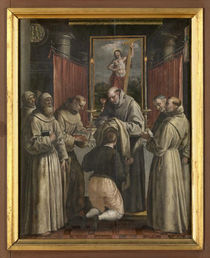The Catholic Defender: Saint John Vianney
- Donald Hartley

- Aug 4
- 3 min read
Updated: Aug 6
Deepertruth with special permission and aid with Franiciscan Media, a great team for the Lord

John Vianney, a humble parish priest, is regarded by the Church as one of its great figures simply because he was faithful. John Vianney was canonized by Pope Pius XI in 1925. He is the only diocesan priest ever to be canonized. He is the patron saint of clergy throughout the world.
A man with vision overcomes obstacles and performs deeds that seem impossible. John Vianney was a man with vision: He wanted to become a priest. But he had to overcome his meager formal schooling, which inadequately prepared him for seminary studies.
At 13-years-old, John made his first communion and prepared for his confirmation in secrecy. He continued to believe in the bravery of priests and received his First Communion catechism instructions in private by two nuns who lost their convents to the Revolution.
His failure to comprehend Latin lectures forced him to discontinue. But his vision of being a priest urged him to seek private tutoring. After a lengthy battle with the books, John was ordained.
As his education had been disrupted by the French Revolution, he struggled in his studies, particularly with Latin, but worked hard to learn.
Situations calling for “impossible” deeds followed him everywhere. As pastor of the parish at Ars, John encountered people who were indifferent and quite comfortable with their style of living. His vision led him through severe fasts and short nights of sleep.
in 1809, John was drafted into Napoleon Bonaparte's armies. He had been studying as an ecclesiastical student, which was a protected title and would normally have excepted him from military services, but Napoleon had withdrawn the exemption in some dioceses as he required more soldiers.
He also worked prodigies like the multiplication of the loaves and fish. Once, when those at the orphanage and school told him in desperation that there was no longer had any food at all to eat, he bowed his head, prayed and send one of the staffers up to the previously empty attic with a cup to bring down some corn.
Inside the church are several side altars that John Vianney built over the years to some of his favorite patrons. St.Philomena, a first-century Roman martyr, and St. John the Baptist, Vianney's own patron, are two of them.
He was deeply devoted to St. Philomena and erected a chapel and shrine in her honor. When he later became deathly ill but miraculously recovered, he attributed his health to St. Philomena's intercession.
With Catherine Lassagne and Benedicta Lardet, he established La Providence, a home for girls. Only a man of vision could have such trust that God would provide for the spiritual and material needs of all those who came to make La Providence their home.
His work as a confessor is John Vianney’s most remarkable accomplishment. In the winter months he was to spend 11 to 12 hours daily reconciling people with God. In the summer months this time was increased to 16 hours. Unless a man was dedicated to his vision of a priestly vocation, he could not have endured this giving of self day after day.
Many people look forward to retirement and taking it easy, doing the things they always wanted to do but never had the time. But John Vianney had no thoughts of retirement. As his fame spread, more hours were consumed in serving God’s people. Even the few hours he would allow himself for sleep were disturbed frequently by the devil.
John Vianney died on August 4, 1859. Over 1,000 people attended his funeral, including the bishop and priests of the diocese, who already viewed his life as a model of priestly holiness. The Holy Curé of Ars was canonized by Pope Pius XI in 1925.
Who, but a man with vision, could keep going with ever-increasing strength? In 1929, Pope Pius XI named him the patron of parish priests worldwide.
On October 3, 1873, Pope Pius IX proclaimed Fr. Vianney as "venerable" and on January 8, 1905, Pope Pius X beatified him. St. John Vianney was canonized on May 31, 1925. His feast day was declared August 9 but it was changed twice before it fell to August 4.





















Comments